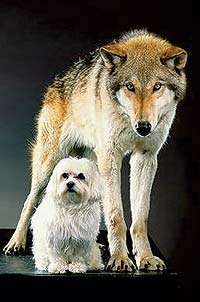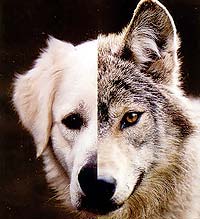The sight of your dog wagging her tail when you come home is one of the most heartwarming experiences that pet owners share. It turns out, this universal sign of greeting may have come from their wolf ancestors. Wolves and dogs share more than 99% of their DNA, and tail wagging is a behavior that seems to have carried over into dogs’ domestication from their wild cousins.
 Most of the time, you see them wag their tails with so-called greeting behavior. Greeting behaviors are effectively behavior shown mostly by subordinate individuals towards dominant individuals, and particularly during reunions after separation. Most of the time, you see them wag their tails with so-called greeting behavior. Greeting behaviors are effectively behavior shown mostly by subordinate individuals towards dominant individuals, and particularly during reunions after separation.
Tail Wags Used for Greeting, Status
Much like dogs, wolves use their tails as a form of communication. As puppies, wolves wag their tails quickly and low to the ground as a sign of status. A low, wagging tail is a sign of subordination to older, more dominant wolves in the pack. Ultimately, it avoids conflict. It is a way to clearly define each other’s roles and not have to argue about things every time that they come up.
It’s common for puppies to wag their tails when the older wolves come back from a hunt, to say hello and signal their place in the pack. This is often combined with lip licking, which triggers adult wolves to regurgitate meat for the young pups. This may remind you of your dog wagging her tail and trying to lick your face if you’ve been gone for a couple of hours. What you will see is this horde of puppies running towards the adults and showing this greeting behavior — so this low tail wagging and this lip licking.
Wolves Use Their Tails to Communicate
A tail held high is a clear sign of dominance in wolf society, while a tail held down is considered to be a sign of submission. Tail tucking is also a form of active submission, typically first used by pups in order to get adults to regurgitate food.
According to the International Wolf Center, submissive behaviors such as tail tucking, crouching and muzzle licking “are retained into adulthood by subordinate wolves, where they function as a gesture of intimacy and the acceptance of the differentiation of the roles of the wolves that are involved.”
Tail position is regularly used in communication by alpha wolves as well, who will hold their tail straight out and slightly raised as a sign of confidence. When wolves are relaxed, a neutral or wagging tail may indicate that the wolf is calm, while tail wagging that takes place during a howling pack rally may be an expression of group excitement and solidarity.
The Wolf Sanctuary of PA explains, “A wagging tail is a sign of a wolf being relaxed. If the tail is slightly drooped and the tip is out, it shows an even more relaxed wolf. If the tail is in a drooping / hanging position the wolf is super relaxed.”
 A stiff tail that is held completely horizontal is another common sight among wolf packs — it’s a sign that the wolf may attack something, perhaps during a hunt. They also noted that a wolf’s tail position is a clear giveaway to its level of submission: A stiff tail that is held completely horizontal is another common sight among wolf packs — it’s a sign that the wolf may attack something, perhaps during a hunt. They also noted that a wolf’s tail position is a clear giveaway to its level of submission:
“From a submissive standpoint there are two obvious tail positions. The first is known as a half tuck, the tail tucks between the legs but does not tuck up against the stomach. When this happens, the wolf is showing a form of submission to a dominant wolf.
In the pack hierarchy this tail tuck can be submissive to any wolf that is higher up the ladder, not just to the alpha. When the tail is tucked all the way between the legs with the tip under the stomach and with an arched back, the wolf is usually in extreme fear, usually a more dominant wolf.”
What Can Your Dog’s Tail Tell You?
Like wolves, dogs use their tails as a form of communication. By paying close attention to the position and movement, you can use your dog’s tail to gain insight into what they’re trying to tell you:
• A tail held high is a sign of alertness and sometimes dominance. The dog will release more of her scent from her anal glands this way, thus making her presence known.
• A tail held high and wagging (with a soft face) is often a sign of happiness, but also alertness (if the face is taught).
• A tail held horizontal to the ground means your dog is exploring.
• A dog that tucks her tail between her legs or wags it low to the ground and quickly may be showing you that she’s nervous, anxious, insecure or feeling shy (the tucked-in position also prevents her scent from being released).
Dog-Friendly Walks/Hikes
in the Moab Area |
Corona Arch - Easy/Moderate. 1.3 Miles one way. Trailhead is 25 minute drive from Moab.
North on US-191 to Potash Road (Utah 279).
Mill Creek Pathway - Easy. 1.1 Miles. Little to no driving. Starts at the intersection of 100 South and 100 West,
a block off of Main Street.
Portal Overlook - Hard. 2.0 Miles one way. Trailhead is 20 minute drive from Moab.
North on US-191 to Potash Road (Utah 279).
Grandstaff Canyon - Moderate. 2.0 Miles one way. Trailhead is 10-minute drive from Moab.
North on US-191 to the River Road (Utah 128) |
|